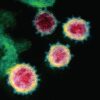Evidence suggests possible RAS-blocker benefit in COVID-19 patients
Patients infected by the COVID-19 virus may benefit from treatments that dampen the renin-angiotensin system, according to a review of several animal studies. These preclinical findings generally support the positions taken in recent week by several cardiology societies that recommended patients taking drugs that moderate the renin-angiotensin system stay on these treatments.
“In patients with cardiovascular disease and SARS-CoV2, the use of ACE inhibitors, ARBs [angiotensin receptor blockers], or MRAs [mineralocorticoid-receptor antagonists] may be favorable as a method to endogenously upregulate ACE2 as a compensatory mechanism that provides anti-inflammatory, antifibrotic, and antithrombotic support as well as reduction in progression of vascular/cardiac remodeling and heart failure,” wrote Jeffrey Bander, MD, and his associates in a report published online (J Am Coll Cardiol. 2020 Apr 15. doi: 10.1016/j.jacc.2020.04.028).
“Based on our review, we hypothesize cardiovascular patients with COVID-19 should remain on RAS [renin-angiotensin system] inhibitors given the protective effects of the ACE2 pathway until RAS blockade is proven to increase the risk to COVID-19,” said the researchers, who are affiliated with the Icahn School of Medicine at Mount Sinai in New York.
COVID-19: U.S. cardiology groups reaffirm continued use of RAAS-active drugs
The ACE2 protein, found both in human blood as well as in cell membranes, especially cells of the lungs, heart, kidneys, and gastrointestinal tissues, functions as both a key enzyme in RAS regulation as well as the primary cell receptor for entry of SARS-CoV2.
Their conclusion jibed with both a joint statement in March from the American College of Cardiology, American Heart Association, and the Heart Failure Society of America; and with the conclusions of a review organized by the European Society of Hypertension’s COVID-19 Task Force (Cardiovasc Res. 2020 Apr 15. doi: 10.1093/cvr/cvaa097).
In their review, the Mount Sinai authors described results from several animal studies suggesting that ACE2 and its associated signaling proteins could potentially be a “valuable therapeutic target.” They also highlighted several clinical intervention studies recently launched to target ACE2, related proteins, and regulation of this arm of the RAS.
Currently, “no data support any conclusive effects of the use of RAS inhibitors in patients with COVID-19,” they concluded. They acknowledged that “the question remains whether the use of ACE inhibitors, ARBs, and MRAs should be avoided in the setting of SARS-CoV infection,” but emphasized that “adequate data on the effects of RAS inhibition in COVID-19 patients is not available,” with more data becoming available soon from ongoing clinical studies.
None of the authors had any disclosures.



